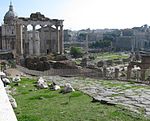Temple of Hercules Victor

The Temple of Hercules Victor ('Hercules the Winner') (Italian: Tempio di Ercole Vincitore) or Hercules Olivarius ((Hercules the Olive Branch Bearear) is a Roman temple in Piazza Bocca della Verità in the area of the Forum Boarium near the Tiber in Rome. It is a tholosa round temple of Greek 'peripteral' design completely surrounded by a colonnade. This layout caused it to be mistaken for a temple of Vesta until it was correctly identified by Napoleon's Prefect of Rome, Camille de Tournon.Despite (or perhaps due to) the Forum Boarium's role as the cattle-market for ancient Rome, the Temple of Hercules is the subject of a folk belief claiming that neither flies nor dogs will enter the holy place. The temple is the earliest surviving marble building in Rome. The Hercules Temple of Victor is also the only surviving sacred temple in ancient Rome that is made of Greek marble. Today it remains unsolved who this temple was dedicated to and for what purpose.
Excerpt from the Wikipedia article Temple of Hercules Victor (License: CC BY-SA 3.0, Authors, Images).Temple of Hercules Victor
Via di Ponte Rotto, Rome Municipio Roma I
Geographical coordinates (GPS) Address Nearby Places Show on map
Geographical coordinates (GPS)
| Latitude | Longitude |
|---|---|
| N 41.8887 ° | E 12.4808 ° |
Address
Foro Boario
Via di Ponte Rotto
00153 Rome, Municipio Roma I
Lazio, Italy
Open on Google Maps










